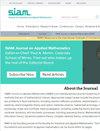具有时变域的反应-扩散系统的全局动力学
IF 2.1
4区 数学
Q1 MATHEMATICS, APPLIED
引用次数: 0
摘要
SIAM 应用数学期刊》,第 84 卷第 4 期,第 1742-1765 页,2024 年 8 月。 摘要本文致力于研究一大类具有时变域的反应扩散系统的全局动力学。通过求助于渐近自治和周期半流理论,我们分别建立了这类系统在渐近有界域和周期域情况下解的长期行为的阈值型结果。为了研究渐近无界域情况下的模型系统,我们首先通过子溶液和超溶液方法证明了扩散系数渐近消失的非自主反应扩散系统的全局吸引力,然后利用比较论证得到了阈值动力学。我们还将这些分析结果应用于登革热传播的反应-扩散模型,研究时变域对基本繁殖数的影响。结果发现,渐近有界域和无界域的登革热传播基本繁殖数总是小于空间均匀情况下的基本繁殖数,而且在适当条件下,渐近有界域和周期域的基本繁殖数大于或等于静止有界域的基本繁殖数。本文章由计算机程序翻译,如有差异,请以英文原文为准。
Global Dynamics of Reaction-Diffusion Systems with a Time-Varying Domain
SIAM Journal on Applied Mathematics, Volume 84, Issue 4, Page 1742-1765, August 2024.
Abstract. This paper is devoted to the study of the global dynamics for a large class of reaction-diffusion systems with a time-varying domain. By appealing to the theories of asymptotically autonomous and periodic semiflows, we establish the threshold-type results on the long-time behavior of solutions for such a system in the cases of asymptotically bounded and periodic domains, respectively. To investigate the model system in the case of asymptotically unbounded domain, we first prove the global attractivity for nonautonomous reaction-diffusion systems with asymptotically vanishing diffusion coefficients via the method of sub- and supersolutions and then use the comparison arguments to obtain the threshold dynamics. We also apply these analytical results to a reaction-diffusion model of dengue fever transmission to investigate the effect of time-varying domain on the basic reproduction number. It turns out that the basic reproduction numbers with dengue fever transmission for the asymptotically bounded and unbounded domains are always less than that for the spatially homogeneous case, and under appropriate conditions, the basic reproduction numbers for asymptotically bounded and periodic domains are larger than or equal to that for the stationary bounded domain.
Abstract. This paper is devoted to the study of the global dynamics for a large class of reaction-diffusion systems with a time-varying domain. By appealing to the theories of asymptotically autonomous and periodic semiflows, we establish the threshold-type results on the long-time behavior of solutions for such a system in the cases of asymptotically bounded and periodic domains, respectively. To investigate the model system in the case of asymptotically unbounded domain, we first prove the global attractivity for nonautonomous reaction-diffusion systems with asymptotically vanishing diffusion coefficients via the method of sub- and supersolutions and then use the comparison arguments to obtain the threshold dynamics. We also apply these analytical results to a reaction-diffusion model of dengue fever transmission to investigate the effect of time-varying domain on the basic reproduction number. It turns out that the basic reproduction numbers with dengue fever transmission for the asymptotically bounded and unbounded domains are always less than that for the spatially homogeneous case, and under appropriate conditions, the basic reproduction numbers for asymptotically bounded and periodic domains are larger than or equal to that for the stationary bounded domain.
求助全文
通过发布文献求助,成功后即可免费获取论文全文。
去求助
来源期刊
CiteScore
3.60
自引率
0.00%
发文量
79
审稿时长
12 months
期刊介绍:
SIAM Journal on Applied Mathematics (SIAP) is an interdisciplinary journal containing research articles that treat scientific problems using methods that are of mathematical interest. Appropriate subject areas include the physical, engineering, financial, and life sciences. Examples are problems in fluid mechanics, including reaction-diffusion problems, sedimentation, combustion, and transport theory; solid mechanics; elasticity; electromagnetic theory and optics; materials science; mathematical biology, including population dynamics, biomechanics, and physiology; linear and nonlinear wave propagation, including scattering theory and wave propagation in random media; inverse problems; nonlinear dynamics; and stochastic processes, including queueing theory. Mathematical techniques of interest include asymptotic methods, bifurcation theory, dynamical systems theory, complex network theory, computational methods, and probabilistic and statistical methods.

 求助内容:
求助内容: 应助结果提醒方式:
应助结果提醒方式:


